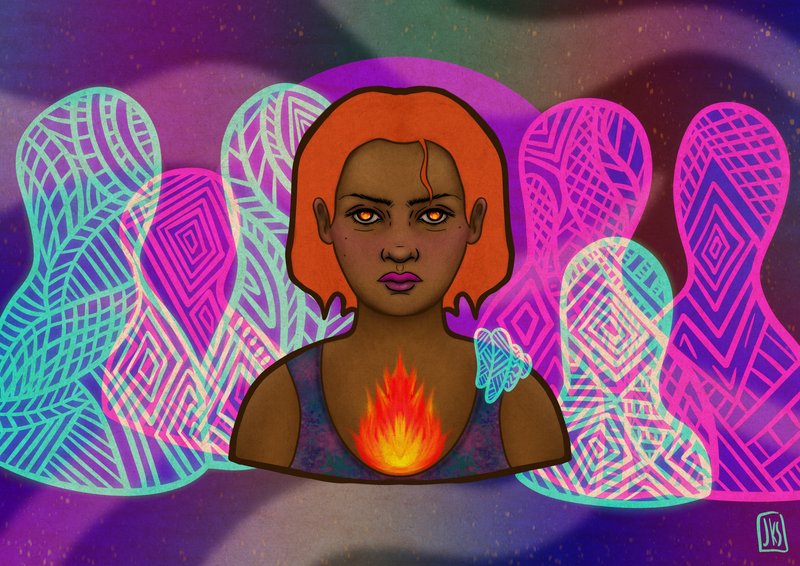Keep the Fire Burning! Blak, Loud and Proud #NAIDOC2024
Join NAVA in celebrating NAIDOC Week and the significant contributions and leadership of First Nations visual artists and storytellers.
Join NAVA in celebrating NAIDOC Week and the significant contributions and leadership of First Nations visual artists and storytellers.

Image: Jarra Karalinar Steel, commissioned by NAVA.
ID: Graphic illustration of a dark-skinned woman from the chest up with bright orange hair and pupils, wearing a gradient purple-blue tank top with a flame over her heart. She is surrounded by pink and blue abstract human-like figures.
Each July, NAIDOC Week (7-14 July 2024) celebrates Aboriginal and Torres Strait Islander cultures, highlighting the resilience and diversity of First Nations communities across the continent. This year’s theme, ‘Keep the Fire Burning! Blak, Loud and Proud,’ emphasises the enduring spirit of First Nations cultures and unapologetic celebration of their identities. The theme reflects ‘a reclamation of narratives, an amplification of voices, and an unwavering commitment to justice and equality.’
NAVA joins in this celebration, recognising the significant contributions and leadership of First Nations visual artists and storytellers. Make a commitment to understanding and respecting First Nations’ self-determination and cultural practices in the arts: engage with available resources and training, attend local NAIDOC community and arts events, redistribute wealth, and support First Nations artists and organisations.
This piece was inspired by this year’s NAIDOC theme, ‘Keep the Fire Burning! Blak, Loud & Proud’. It represents our ancestors' murrup (spirit) and those who paved the way for us. They stand behind us, giving us strength to keep our fires burning bright. Their resilience, hard work, and care for community and country are the foundation of our pride and identity. This artwork is to remind us that we are never alone and that those ancestors and those staunch pioneers are always with us. Community and culture are woven into our being, connecting us through generations. We carry their flame within us, an unbroken chain of strength and resilience.
Amanda Jane Reynolds is a Guringai and Yuin possum cloak-maker, multimedia artist, curator and storyteller who works with southeastern cultural traditions. In this interview, Reynolds reflects on supporting Senior Cloak Teachers and Elders in the cultural reclamation of possum skin cloaks through Banmirra Arts, overcoming her own hesitation to create cloaks, and gaining confidence and connection to her cultural heritage.
Katie West, an artist and Yindjibarndi woman in Noongar Ballardong boodja (North East of Perth), experiments in a 'custodial ethic' in her practice, as termed by Murri academic Mary Graham, grounded in the understanding that the health of human society and Country mirror one another. Her installations, textile pieces, and happenings invite attention to the ways we weave our histories, places, and more-than-human kinships. In this video, West discusses the deep concern for the environment, climate change and overconsumption, the importance of new perspectives and circling back to old ideas, and the therapeutic role of art in understanding her own familial histories.
Nicole Foreshew is a Wiradjuri artist, writer and curator living and working based on Gumbaynggirr Country, Central West NSW. She works across photomedia, sculpture, film and video, using technical mediums and natural materials such as clay, pigments, plant matter, light, water and fog. In this video, Foreshew chats to NAVA about the importance of recognising artists as workers, the need for Aboriginal and Torres Strait Islander perspectives in decision-making processes, and the potential of art to heal, voice complex ideas, and share experiences.
Christopher Bassi, a Meriam and Yupungathi man in Meanjin/Brisbane, works with archetypal models of representational painting to explore cultural identity, alternative genealogies, and colonial legacies in Australia and the South Pacific. In this interview, Bassi emphasises the importance of making art through uncertainty, contextualising work within the environment of your work, and supporting the people around you.
Organisations and individuals wishing to collaborate with First Nations artists and communities have a responsibility to follow ethical industry practices and protocols. Use the following resources and guides to strengthen cultural competency, and to recognise and address bias.
NAVA resources
External resources
Workshops
Support First Nations artists by purchasing art from Aboriginal and Torres Strait Islander-owned businesses, First Nations Art Centres, galleries registered with the Indigenous Art Code or from independent First Nations artists directly. For information on how to buy art ethically, visit the Indigenous Art Code. For links to ethical dealers and First Nations Art Centres around the country, search members of the Indigenous Art Code or visit the peak bodies:
In NSW
In Vic
The National Association for the Visual Arts (NAVA) is a national organisation with staff who work across multiple states. The NAVA Board, and the artists, arts workers and organisations that we represent are based across hundreds of sovereign nations and unceded lands throughout the continent that has become colonially known as Australia.
NAVA acknowledges the Traditional Owners, Custodians and knowledge-holders of the unceded lands on which we live, learn, and work. We acknowledge Aboriginal and Torres Strait Islander peoples as the first artists and storytellers on this continent and pay respect to First Nations communities' ancestors and Elders. Sovereignty was never ceded. Always was, always will be Aboriginal land.